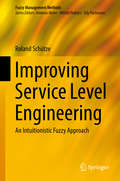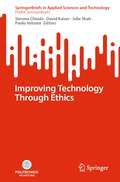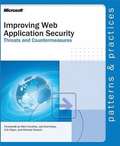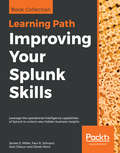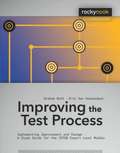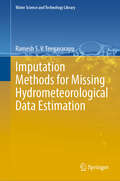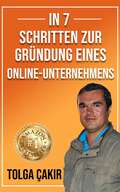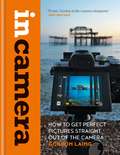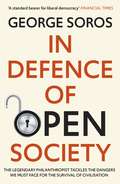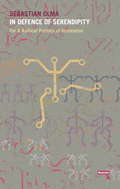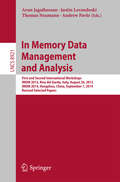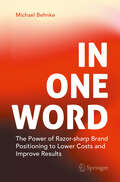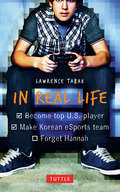- Table View
- List View
Improving Operating Leverage Using Hyperautomation: Unlock Strategic Advantages Across Banking and Non-Banking Financial Institutions
by Kannan Subramanian RImproving operating leverage is about operational resilience, structural operational efficiency, and sustainable revenue growth. Activity-based enterprise non-interest cost management is an important component of enterprise risk adjusted return management methodology. This book builds on the author Kannan Subramanian’s earlier book, Event- and Data-Centric Enterprise Risk-Adjusted Return Management, delving in depth into enterprise non-interest operating cost management and operating leverage. Operating Leverage is about managing a bank’s capabilities and its capacity to deliver its products and services efficiently. It is not limited to managing operational costs but includes the operational support for the growth of business and for improving profitability. Profit is an absolute measure that denotes the amount of money the bank makes after deducting all expenses. Profitability measures how efficient the bank is at utilizing its resources to generate risk-adjusted returns. The reader can learn to improve risk adjusted operational effectiveness by implementing a nuanced approach to managing performance, risk, control, and cost simultaneously, at the process level. You’ll examine how some institutions have implemented activity-based costing in a siloed environment and without enterprise process automation. Many institutions do not have a scientific way of managing non-interest costs. The book explains why hyperautomation, a technology that intelligently automates business processes, is a more advanced and comprehensive way to manage these factors in a holistic and integrated way. Improving Operating Leverage using Hyperautomation is your complete guide to enhancing risk adjusted operational performance through a nuanced approach to performance, risk, control, and costs at the process level. What You Will Learn Define and use the bill of resources to improve operating leverage. Implement activity-based enterprise non-interest cost management using hyperautomation Monitor performance, risk, control, and cost at the process level. Implement time-driven activity-based costing for an enterprise risk-adjusted return model. Who This Book Is For Most banking industry professionals, including senior management teams, consultants, central bankers, financial regulators, software vendors, and Business Process Management Suite/Hyperautomation technology vendors.
Improving Service Level Engineering
by Roland SchützeThis book examines how fuzzy methods can be employed to manage service levels in business and IT alignment. It starts by mapping the dependencies of service level agreements, coming up with gradual and bi-polar concepts to eventually classify the level of coupling by intuitionistic fuzzy sets. The second part presents an approach to analyze the impact of service failures using intuitionistic fuzzy methods (IFSFIA). Lastly, the third part of the book extends the concept towards business and IT-aligned service-level engineering and provides two use cases.
Improving Software Testing: Technical and Organizational Developments
by Tim A. MajchrzakSoftware is continuously increasing in complexity. Paradigmatic shifts and new development frameworks make it easier to implement software - but not to test it. Software testing remains to be a topic with many open questions with regard to both technical low-level aspects and to the organizational embedding of testing. However, a desired level of software quality cannot be achieved by either choosing a technical procedure or by optimizing testing processes. In fact, it requires a holistic approach.This Brief summarizes the current knowledge of software testing and introduces three current research approaches. The base of knowledge is presented comprehensively in scope but concise in length; thereby the volume can be used as a reference. Research is highlighted from different points of view. Firstly, progress on developing a tool for automated test case generation (TCG) based on a program's structure is introduced. Secondly, results from a project with industry partners on testing best practices are highlighted. Thirdly, embedding testing into e-assessment of programming exercises is described.
Improving Soil Fertility Recommendations in Africa using the Decision Support System for Agrotechnology Transfer (DSSAT)
by Andre Bationo Job Kihara Gerrit Hoogenboom Ramadjita Tabo Dougbedji Fatondji James W JonesThe book gives a detailed description of the application of DSSAT in simulating crop and soil processes within various Agro-ecological zones in Africa. The book, an output of a series of 3 workshops, provides examples of the application of DSSAT models to simulate nitrogen applications, soil and water conservation practices including effects of zai technology, phosphorus and maize productivity, generation of genetic coefficients, long-term soil fertility management technologies in the drylands, microdosing, optimization of nitrogen x germplasms x water, spatial analysis of water and nutrient use efficiencies and, tradeoff analysis. The minimum dataset requirements for DSSAT is discussed. This book arises from attempts to address the limited use of models in decision support by African agricultural (both soil scientist and agronomists) scientists.
Improving Technology Through Ethics (SpringerBriefs in Applied Sciences and Technology)
by David Kaiser Julie Shah Simona Chiodo Paolo VolontéThis book deals with the ethics of technology and addresses specific ethical problems related to some emerging technologies, mainly in the field of computer science (from machine learning models to extracting value from data to human–robot interaction). The contributions are authored mainly by scholars in ICT and other engineering fields who reflect on ethical and societal issues emerging from their own research activity. Thus, rather uniquely, the work overcomes the traditional divide between pure ethical theory that disregards what practitioners do and mere R&D practice that ignores what theorists conceptualize. Conversely, the reader is enabled to understand what ethics means when it is actually put into work by engineering researchers. The book arises from a joint program between MIT and Politecnico di Milano aimed at training early career researchers in addressing the ethical issues of technology and critically reflecting on the social impacts of the emerging, and even disruptive, technologies they are currently developing through their novel research. Overall, it aims at spreading the task of developing technologies that, from the beginning, are designed to be responsible for human life, society, and nature.
Improving Web Application Security: Threats and Countermeasures
by Microsoft CorporationGain a solid foundation for designing, building, and configuring security-enhanced, hack-resistant Microsoft® ASP.NET Web applications. This expert guide describes a systematic, task-based approach to security that can be applied to both new and existing applications. It addresses security considerations at the network, host, and application layers for each physical tier--Web server, remote application server, and database server--detailing the security configurations and countermeasures that can help mitigate risks. The information is organized into sections that correspond to both the product life cycle and the roles involved, making it easy for architects, designers, and developers to find the answers they need. All PATTERNS & PRACTICES guides are reviewed and approved by Microsoft engineering teams, consultants, partners, and customers--delivering accurate, real-world information that's been technically validated and tested.
Improving Your Splunk Skills: Leverage the operational intelligence capabilities of Splunk to unlock new hidden business insights
by Josh Diakun Derek Mock James D. Miller Paul R. JohnsonTransform machine-generated data into valuable business insights using the powers of Splunk Key Features Explore the all-new machine learning toolkit in Splunk 7.x Tackle any problems related to searching and analyzing your data with Splunk Get the latest information and business insights on Splunk 7.x Book Description Splunk makes it easy for you to take control of your data and drive your business with the cutting edge of operational intelligence and business analytics. Through this Learning Path, you'll implement new services and utilize them to quickly and efficiently process machine-generated big data. You'll begin with an introduction to the new features, improvements, and offerings of Splunk 7. You'll learn to efficiently use wildcards and modify your search to make it faster. You'll learn how to enhance your applications by using XML dashboards and configuring and extending Splunk. You'll also find step-by-step demonstrations that'll walk you through building an operational intelligence application. As you progress, you'll explore data models and pivots to extend your intelligence capabilities. By the end of this Learning Path, you'll have the skills and confidence to implement various Splunk services in your projects. This Learning Path includes content from the following Packt products: Implementing Splunk 7 - Third Edition by James Miller Splunk Operational Intelligence Cookbook - Third Edition by Paul R Johnson, Josh Diakun, et al What you will learn Master the new offerings in Splunk: Splunk Cloud and the Machine Learning Toolkit Create efficient and effective searches Master the use of Splunk tables, charts, and graph enhancements Use Splunk data models and pivots with faster data model acceleration Master all aspects of Splunk XML dashboards with hands-on applications Apply ML algorithms for forecasting and anomaly detection Integrate advanced JavaScript charts and leverage Splunk's API Who this book is for This Learning Path is for data analysts, business analysts, and IT administrators who want to leverage the Splunk enterprise platform as a valuable operational intelligence tool. Existing Splunk users who want to upgrade and get up and running with Splunk 7.x will also find this book useful. Some knowledge of Splunk services will help you get the most out of this Learning Path.
Improving the Air Force Scientific Discovery Mission: A Workshop Report
by Committee on Improving the Air Force Scientific Discovery Mission: Leveraging Best Practices in Basic Research Management: A WorkshopIn 2015, the Air Force Studies Board conducted a workshop, consisting of two data-gathering sessions, to review current research practices employed by the Air Force Office of Scientific Research (AFOSR). Improving the Air Force Scientific Discovery Mission summarizes the presentations and discussions of these two sessions. This report explores the unique drivers associated with management of a 6. 1 basic research portfolio in the Department of Defense and investigates current and future practices that may further the effective and efficient management of basic research on behalf of the Air Force
Improving the Performance of Wireless LANs: A Practical Guide
by Nurul SarkarWhile there are countless books on wireless networks, few actually quantify the key performance-limiting factors of wireless local area networks (WLANs) and describe various methods for improving WLAN performance. Fulfilling these needs, Improving the Performance of Wireless LANs: A Practical Guide provides both theoretical background and empirical
Improving the Quality of ABAP Code: Striving for Perfection
by Paul David HardyGain an in-depth understanding of the large number of common problems found in ABAP programs and have a robust methodology for fixing problems when you find them. This book also shows you how to prevent them from occurring in new programs.A large chunk of the world’s biggest organizations use SAP software and virtually all of them have very large amounts of custom code. However, a lot of that custom code is not as good as it could be. In this book we look at why object-oriented programming is the basic building block for improved program quality and at the test-driven development that this enables. We cover the three pillars of clarity, stability, and high performance on which a high-quality ABAP program stands. You will then move on to the user interface, which needs its own set of standards for high quality. In the final chapters, you will learn about specialist topics such as user exits, making sure code will run on the latest releases of SAP, and how to add your own automated custom code quality checks. What You Will Learn Know why object-oriented programming and test-driven development are the cornerstones of high-quality custom code Ensure that the three pillars of clarity, stability, and high performance are fulfilled Make sure your applications are user friendlyEnsure that your custom code works on newer SAP releasesCreate your own custom code quality checks Who This Book Is ForABAP developers who started yesterday or have been programming for 20 years
Improving the Test Process
by Graham Bath Erik Van VeenendaalThis book covers the syllabus for the Improving the Test Process module of the International Software Testing Qualifications Board (ISTQB) Expert Level exam. To obtain certification as a professional tester at the Expert Level, candidates may choose to take a course given by an ISTQB accredited training provider and then sit for the exam. Experience shows that many candidates who choose this path still require a reference book that covers the course. There are also many IT professionals who choose self-study as the most appropriate route toward certification. This book can be used both as a preparation guide for those planning to take the ISTQB Expert Level certification exam and as a practical guide for experienced testing professionals who want to develop their skills in improving test processes.
Improving your C# Skills: Solve modern challenges with functional programming and test-driven techniques of C#
by Rod Stephens John Callaway Clayton Hunt Ovais Mehboob Ahmed KhanConquer complex and interesting programming challenges by building robust and concurrent applications with caches, cryptography, and parallel programming.Key FeaturesUnderstand how to use .NET frameworks like the Task Parallel Library (TPL)and CryptoAPIDevelop a containerized application based on microservices architectureGain insights into memory management techniques in .NET CoreBook DescriptionThis Learning Path shows you how to create high performing applications and solve programming challenges using a wide range of C# features. You’ll begin by learning how to identify the bottlenecks in writing programs, highlight common performance pitfalls, and apply strategies to detect and resolve these issues early. You'll also study the importance of micro-services architecture for building fast applications and implementing resiliency and security in .NET Core. Then, you'll study the importance of defining and testing boundaries, abstracting away third-party code, and working with different types of test double, such as spies, mocks, and fakes. In addition to describing programming trade-offs, this Learning Path will also help you build a useful toolkit of techniques, including value caching, statistical analysis, and geometric algorithms. This Learning Path includes content from the following Packt products:C# 7 and .NET Core 2.0 High Performance by Ovais Mehboob Ahmed KhanPractical Test-Driven Development using C# 7 by John Callaway, Clayton HuntThe Modern C# Challenge by Rod StephensWhat you will learnMeasure application performance using BenchmarkDotNetLeverage the Task Parallel Library (TPL) and Parallel Language Integrated Query (PLINQ)library to perform asynchronous operationsModify a legacy application to make it testableUse LINQ and PLINQ to search directories for files matching patternsFind areas of polygons using geometric operationsRandomize arrays and lists with extension methodsUse cryptographic techniques to encrypt and decrypt strings and filesWho this book is forIf you want to improve the speed of your code and optimize the performance of your applications, or are simply looking for a practical resource on test driven development, this is the ideal Learning Path for you. Some familiarity with C# and .NET will be beneficial.
Improving your Penetration Testing Skills: Strengthen your defense against web attacks with Kali Linux and Metasploit
by Abhinav Singh Juned Ahmed Ansari Gilberto Najera-Gutierrez Daniel TeixeiraEvade antiviruses and bypass firewalls with the most widely used penetration testing frameworks Key Features Gain insights into the latest antivirus evasion techniques Set up a complete pentesting environment using Metasploit and virtual machines Discover a variety of tools and techniques that can be used with Kali Linux Book Description Penetration testing or ethical hacking is a legal and foolproof way to identify vulnerabilities in your system. With thorough penetration testing, you can secure your system against the majority of threats. This Learning Path starts with an in-depth explanation of what hacking and penetration testing is. You'll gain a deep understanding of classical SQL and command injection flaws, and discover ways to exploit these flaws to secure your system. You'll also learn how to create and customize payloads to evade antivirus software and bypass an organization's defenses. Whether it's exploiting server vulnerabilities and attacking client systems, or compromising mobile phones and installing backdoors, this Learning Path will guide you through all this and more to improve your defense against online attacks. By the end of this Learning Path, you'll have the knowledge and skills you need to invade a system and identify all its vulnerabilities. This Learning Path includes content from the following Packt products: Web Penetration Testing with Kali Linux - Third Edition by Juned Ahmed Ansari and Gilberto Najera-Gutierrez Metasploit Penetration Testing Cookbook - Third Edition by Abhinav Singh , Monika Agarwal, et al What you will learn Build and analyze Metasploit modules in Ruby Integrate Metasploit with other penetration testing tools Use server-side attacks to detect vulnerabilities in web servers and their applications Explore automated attacks such as fuzzing web applications Identify the difference between hacking a web application and network hacking Deploy Metasploit with the Penetration Testing Execution Standard (PTES) Use MSFvenom to generate payloads and backdoor files, and create shellcode Who this book is for This Learning Path is designed for security professionals, web programmers, and pentesters who want to learn vulnerability exploitation and make the most of the Metasploit framework. Some understanding of penetration testing and Metasploit is required, but basic system administration skills and the ability to read code are a must.
Imputation Methods for Missing Hydrometeorological Data Estimation (Water Science and Technology Library #108)
by Ramesh S.V. TeegavarapuMissing data is a ubiquitous problem that plagues many hydrometeorological datasets. Objective and robust spatial and temporal imputation methods are needed to estimate missing data and create error-free, gap-free, and chronologically continuous data. This book is a comprehensive guide and reference for basic and advanced interpolation and data-driven methods for imputing missing hydrometeorological data. The book provides detailed insights into different imputation methods, such as spatial and temporal interpolation, universal function approximation, and data mining-assisted imputation methods. It also introduces innovative spatial deterministic and stochastic methods focusing on the objective selection of control points and optimal spatial interpolation. The book also extensively covers emerging machine learning techniques that can be used in spatial and temporal interpolation schemes and error and performance measures for assessing interpolation methods and validating imputed data. The book demonstrates practical applications of these methods to real-world hydrometeorological data. It will cater to the needs of a broad spectrum of audiences, from graduate students and researchers in climatology and hydrological and earth sciences to water engineering professionals from governmental agencies and private entities involved in the processing and use of hydrometeorological and climatological data.
In 7 Schritten Zur Gründung Eines Online-Unternehmens (Financial Investments #1)
by Tolga CakirDie Gründung eines Online-Unternehmens ist ein großes Unterfangen. Um Ihnen diese große Aufgabe zu erleichtern, ist sie in diesem Buch in sieben logische Schritte unterteilt, von denen sich viele auf das konzentrieren, was Sie tun müssen, sobald Sie Ihre Seite eingerichtet haben und sie läuft. Weitere Informationen erläutern die Besonderheiten von Buchhaltungssoftware, den Kauf und Verkauf von Anzeigen auf Websites und vieles mehr. Die ersten Schritte sind immer die schwersten. Wenn Sie erst einmal so weit sind, werden Sie feststellen, dass die Dinge viel einfacher werden und dass der Erfolg in Ihrem Unternehmen nicht nur ein Traum ist, sondern eine reale Möglichkeit, vorausgesetzt, Sie gehen die Dinge auf die richtige Weise an!
In Athena's Camp
by David Ronfeldt John ArquillaThe information revolution--which is as much an organizational as a technological revolution--is transforming the nature of conflict across the spectrum: from open warfare, to terrorism, crime, and even radical social activism. The era of massed field armies is passing, because the new information and communications systems are increasing the lethality of quite small units that can call in deadly, precise missile fire almost anywhere, anytime. In social conflicts, the Internet and other media are greatly empowering individuals and small groups to influence the behavior of states. Whether in military or social conflicts, all protagonists will soon be developing new doctrines, strategies, and tactics for swarming their opponents--with weapons or words, as circumstances require. Preparing for conflict in such a world will require shifting to new forms of organization, particularly the versatile, hardy, all-channel network. This shift will prove difficult for states and professional militaries that remain bastions of hierarchy, bound to resist institutional redesign. They will make the shift as they realize that information and knowledge are becoming the key elements of power. This implies, among other things, that Mars, the old brute-force god of war, must give way to Athena, the well-armed goddess of wisdom. Accepting Athena as the patroness of this information age represents a first step not only for preparing for future conflicts, but also for preventing them.
In Camera: How to Get Perfect Pictures Straight Out of the Camera
by Gordon LaingWith amazing low-light capabilities, incredible definition, intelligent autofocus and a host of other features, digital cameras have now become so powerful that they have left their users behind. Most photographers can take competent shots in a range of conditions, or fix imperfect exposures in Photoshop or Lightroom, but very few have the skill to push their cameras to the limit and capture the perfect shot, under all conditions, with no post-processing required.In Camera is the perfect way to take your photography to that level; to master your camera, understand light, exposure and composition, and make amazing photographs, whatever your camera, without cheating after the event. One hundred of Gordon's beautiful photos are given with his own expert commentary; full settings and camera details are included, and a host of tips and tricks let photographers of any level learn something from every example. The shots are taken with a wide range of cameras, and the emphasis is on getting results by improving your own skills, not wasting money on expensive equipment.
In Camera: Perfect Pictures Straight Out Of The Camera
by Gordon LaingWith amazing low-light capabilities, incredible definition, intelligent autofocus and a host of other features, digital cameras have now become so powerful that they have left their users behind. Most photographers can take competent shots in a range of conditions, or fix imperfect exposures in Photoshop or Lightroom, but very few have the skill to push their cameras to the limit and capture the perfect shot, under all conditions, with no post-processing required.In Camera is the perfect way to take your photography to that level; to master your camera, understand light, exposure and composition, and make amazing photographs, whatever your camera, without cheating after the event. One hundred of Gordon's beautiful photos are given with his own expert commentary; full settings and camera details are included, and a host of tips and tricks let photographers of any level learn something from every example. The shots are taken with a wide range of cameras, and the emphasis is on getting results by improving your own skills, not wasting money on expensive equipment.
In Defence of Open Society: The Legendary Philanthropist Tackles the Dangers We Must Face for the Survival of Civilisation
by George SorosGeorge Soros is among the world's most prominent public figures. He is one of the history's most successful investors and his philanthropy, led by the Open Society Foundations, has donated over $14 billion to promote democracy and human rights in more than 120 countries. But in recent years, Soros has become the focus of sustained right-wing attacks in the United States and around the world based on his commitment to open society, progressive politics and his Jewish background. In this brilliant and spirited book, Soros offers a compendium of his philosophy, a clarion call-to-arms for the ideals of an open society: freedom, democracy, rule of law, human rights, social justice, and social responsibility as a universal idea. In this age of nationalism, populism, anti-Semitism, and the spread of authoritarian governments, Soros's mission to support open societies is as urgent as it is important.
In Defence of Serendipity
by Seb OlmaIn Defence of Serendipity is a lively and buccaneering work of investigative philosophy, treating the origins of "serendipity, accident and sagacity", both as riddles and philosophical concepts that can be put to a future political use. Taking in Aristotle, LSD, Tony Blair and techno-mysticism, Olma challenges the prevailing faith in the benevolence of digital technology and the illegitimate equation of innovation and entrepreneurship, arguing instead that we must take responsibility for the care of society's digital infrastructure, and prevent its degeneration into an apparatus of marketing and finance. For although there is nothing wrong with marketing and finance per se, if they alone lead technological development, free of any discretionary political interference, the freedom to be exploited will be as much a part of the future as our ability to intervene freely in our lives, will be a thing of the past.
In Memory Data Management and Analysis
by Arun Jagatheesan Justin Levandoski Thomas Neumann Andrew PavloThis book constitutes the thoroughly refereed post conference proceedings of the First and Second International Workshops on In Memory Data Management and Analysis held in Riva del Garda, Italy, August 2013 and Hangzhou, China, in September 2014. The 11 revised full papers were carefully reviewed and selected from 18 submissions and cover topics from main-memory graph analytics platforms to main-memory OLTP applications.
In One Word: The Power of Razor-sharp Brand Positioning to Lower Costs and Improve Results
by Michael Behnke"In One Word" analyzes and discusses the underlying dynamics, as well as the unique technique and methodology of defining a brand&’s value proposition in just one word. This book offers deep insights to marketers and communication professionals, helping them to better understand what it takes to build successful brands. Many of today&’s power brands are succeeding in defining what they stand for in a single word. When executed properly, a one-word brand positioning is unleashing powerful synergies in the brand-building and management process by aligning everyone involved in the same strategic direction. Through this approach, a company's resourcefulness, energy, and creativity are being bundled and directed towards the same objective. In this surprising approach to branding, a single word is ultimately driving the entire brand-related marketing and sales operation. For instance, &“Glamour&” drives the L&’Oréal Paris brand, while Nivea stands for &“Care.&” Michael Behnke provides practical guidance on building power brands, offering tangible advice and real-life illustrations to empower branding professionals in their quest to build unique brands that deliver rewarding results.
In Our Own Image: Savior or Destroyer? The History and Future of Artificial Intelligence
by George ZarkadakisA timely and important book that explores the history and future, as well as the societal and ethical implications, of Artificial Intelligence as we approach the cusp of a fourth industrial revolution Zarkadakis explores one of humankind's oldest love-hate relationships—our ties with artificial intelligence, or AI. He traces AI's origins in ancient myth, through literary classics like Frankenstein, to today's sci-fi blockbusters, arguing that a fascination with AI is hardwired into the human psyche. He explains AI's history, technology, and potential; its manifestations in intelligent machines; its connections to neurology and consciousness, as well as—perhaps most tellingly—what AI reveals about us as human beings. In Our Own Image argues that we are on the brink of a fourth industrial revolution—poised to enter the age of Artificial Intelligence as science fiction becomes science fact. Ultimately, Zarkadakis observes, the fate of AI has profound implications for the future of science and humanity itself.
In Real Life
by Jon MitchellTechnology helps us with our hardest work. It can also offer us endless distractions. Can technology enable us, as individuals and communities, to do our greatest possible work, the hard work of being a good person?Jon Mitchell sets out to identify and explore the ways in which we can develop a more thoughtful relationship with technology. Rather than using technology as a medium for connecting with the world, he recommends we rethink our relationship with technology, using it as a resource that allows us to have a more intimate and personal relationship with the world around us, nature, and our loved ones. Mitchell offers concrete practices for the way we use technology in our daily lives.With an accessible and conversational, easy-to-read style, Mitchell uses his years of experience as both a tech journalist and a mindfulness practitioner, to propose a rethinking of both the design of technology and its use.
In Real Life
by Lawrence TabakFifteen-year-old math prodigy Seth Gordon knows exactly what he wants to do with his life-play video games. Every spare minute is devoted to honing his skills at Starfare, the world's most popular computer game. His goal: South Korea, where the top pros are rich and famous. But the best players train all day, while Seth has school and a job and divorced parents who agree on only one thing: "Get off that damn computer. " Plus there's a new distraction named Hannah, an aspiring photographer who actually seems to understand his obsession. While Seth mopes about his tournament results and mixed signals from Hannah, Team Anaconda, one of the leading Korean pro squads, sees something special. Before he knows it, it's goodbye Kansas, goodbye Hannah, and hello to the strange new world of Korea. But the reality is more complicated than the fantasy, as he faces cultural shock, disgruntled teammates, and giant pots of sour-smelling kimchi. What happens next surprises Seth. Slowly, he comes to make new friends, and discovers what might be a breakthrough, mathematical solution to the challenges of Starcraft. Delving deeper into the formulas takes him in an unexpected direction, one that might just give him a new focus-and reunite him with Hannah.

